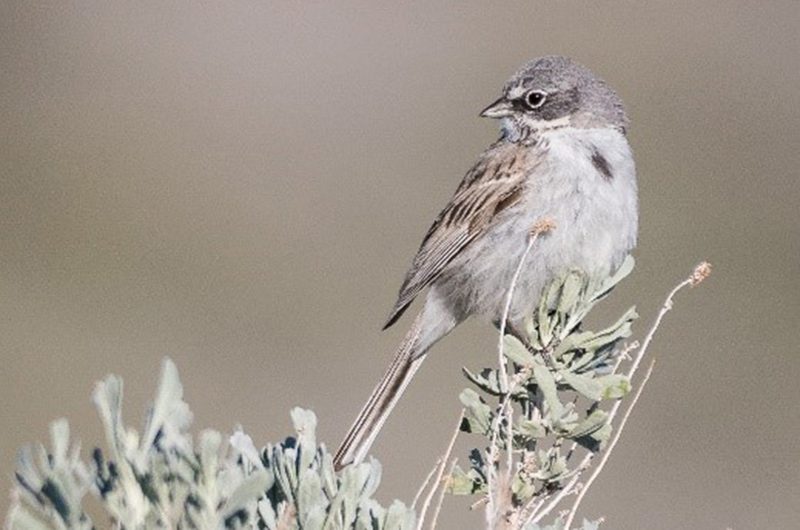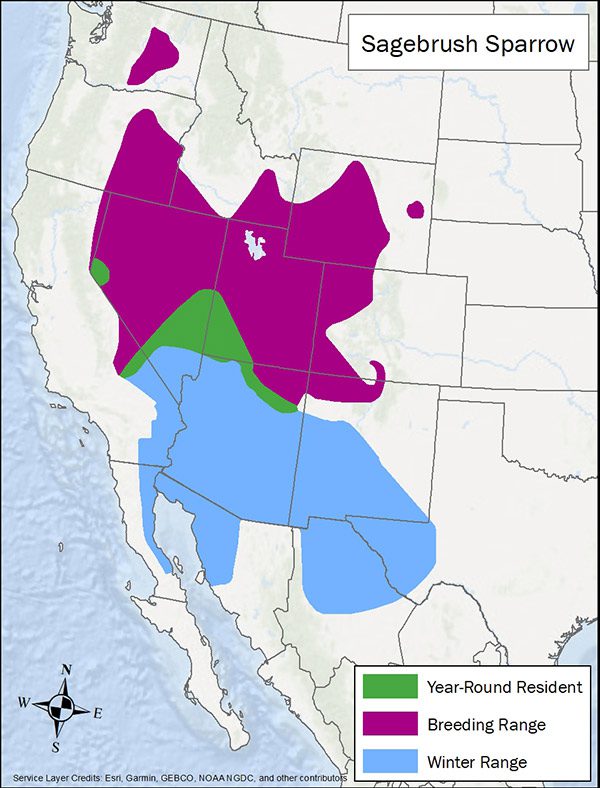LandPKS Learning
Habitat Hub

Sagebrush Sparrow
Breeding territories vary in size and shape, but sagebrush sparrows can maintain some of the largest territories known for any sparrow species. Where sagebrush sparrows are uncommon, their territories can increase in size without limit. Also, the sagebrush sparrow has been split and lumped with Bell’s sparrow, but was recently split again as a separate species. Bell’s sparrow is found in California, southern Nevada, and Baja California.
Artemisiospiza nevadensis
Identification
Sagebrush sparrows are a medium-sized sparrow (5-6 in/12-15 cm) with a relatively long tail that is dark with lighter edges. Males and females look similar: a gray, rounded head, a white spot in front of each eye, a white “mustache,” a brown back, and white underparts with a black dot on the breast.
Observation Tips
During the breeding season, sagebrush sparrows are commonly found in sagebrush and other shrublands throughout the Great Basin region. Males can be heard singing their cheerful song from the tops of sagebrush and other shrubs. When not singing, look for sagebrush sparrows feeding on the ground or running between shrubs. They spend their winters foraging in small groups in the arid shrublands and grasslands of southwestern U.S. and northern Mexico.
Interesting Fact
Breeding territories vary in size and shape, but sagebrush sparrows can maintain some of the largest territories known for any sparrow species. Where sagebrush sparrows are uncommon, their territories can increase in size without limit. Also, the sagebrush sparrow has been split and lumped with Bell’s sparrow, but was recently split again as a separate species. Bell’s sparrow is found in California, southern Nevada, and Baja California.
Ideal Habitat
Sagebrush sparrows breed in semi-open shrub-steppe habitat throughout the Great Basin region. In the spring and summer, they are commonly found in big sagebrush shrublands where shrubs are evenly spaced (10-40% shrub cover), and up to 6 ft/2 m tall. They also breed in sagebrush communities. They only rarely breed in sagebrush-juniper communities that are adjacent to sagebrush shrublands. They typically nest low in a shrub, but also occasionally on the ground under a shrub or in a bunchgrass. Shrubs used for nesting are typically taller with a larger canopy than surrounding shrubs, and include big sagebrush, bitterbrush, rabbitbrush, and greasewood. In the winter, sagebrush sparrows may use big sagebrush shrublands, arid shrublands, and grasslands with creosote, saltbush, yucca, mesquite, and greasewood.

Range map provided by BirdLife International
Management Activities that Benefit Species – Best Management Practices (BMPs)
Maintain large patches of sagebrush shrublands, especially old, open stands. Control invasive plants, such as cheatgrass, and also encroaching trees. Juniper removal may lead to increased densities of sparrows. Moderate grazing is compatible with sagebrush sparrow habitat.
Management Activities to Avoid
Avoid shrub treatments (e.g., mechanical thinning) in the late spring and early summer to reduce nest disturbance for breeding sagebrush sparrows. Avoid any activity that reduces sagebrush cover has the potential to negatively impact the species, such as prescribed fire, herbicide application, chaining, mowing, and other mechanical shrub removal practices.
Other Species that Benefit from Similar Habitat Management
Other sagebrush-obligate species will likely benefit from habitat management for sagebrush sparrows, such as sage thrashers, Brewer’s sparrows, greater sage-grouse, and pygmy rabbits.
Download
Download the sagebrush sparrow factsheet
Other Resources
Bird Conservancy of the Rockies. 2015. Integrating birds into sagebrush management. Brighton, CO. 89 pp.
BirdLife International and Handbook of the Birds of the World. 2019. Bird species distribution maps of the world. Version 2019.1. Sagebrush Sparrow
The Cornell Lab of Ornithology, Birds of the World Sagebrush Sparrow
The Cornell Lab of Ornithology. All About Birds Sagebrush Sparrow
.Photo credit: Becky Matsubara/Flickr
Mobile App | Data Portal | Knowledge Hub | Habitat Hub | Learning Collections | Blog | About | Contact | Support



